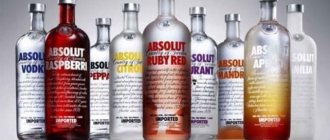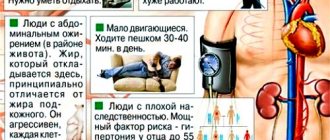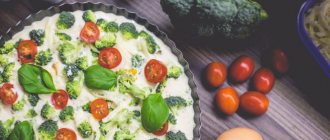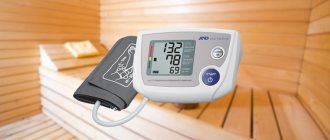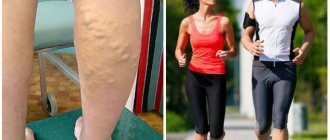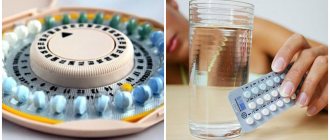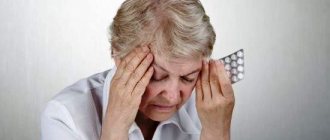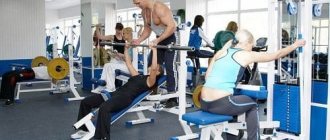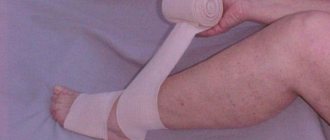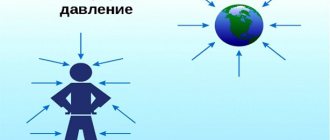With each contraction of the heart muscles, the walls of the blood vessels and aorta are stretched, allowing a new portion of blood to pass through. But, like a tense spring, they will resist such stretching, creating pressure on the blood.
The force with which the heart presses on the blood is called blood pressure. During systole the pressure increases and during diastole it decreases. Therefore, they distinguish between maximum and minimum pressure.
Pressure is measured using a special device. This is done in the region of the brachial artery. In a healthy person, a blood pressure of 120/75 millimeters of mercury is considered normal.
The further the blood is from the heart, the lower the force of blood pressure will be, since energy is spent on friction between the walls of blood vessels and the blood. In large veins the pressure drops to almost 0.
At the moment when the vessels narrow, the blood pressure in them increases, and therefore the heart has to work harder. In this case, the pressure increases.
A special role is played by arterioles, in which the muscular system is highly developed. When they expand, the pressure decreases, and when they contract, the pressure increases.
High pressure
Before talking about high blood pressure, you need to be aware of what the term “blood pressure” means.
From a mathematical point of view, blood pressure is a value equal to the volume of blood pumped by the heart in a certain period of time and the resistance of the vascular bed.
There is also a simple definition: this is a significant parameter characterizing the activity of blood in the body. When measuring pressure, everyone sees two values: upper and lower. In a healthy person without pathologies, the upper value is approximately one hundred and ten, the lower – seventy. High pressure values are those that exceed the norm by ten percent or more.
By not paying attention to high blood pressure indicators, you risk having a stroke, heart attack, kidney failure, visual impairment, and so on.
Symptoms of high blood pressure include nausea, pain in the heart and head, trembling, and fear.
Signs of narrowing of the blood vessels of the heart
Coronary arteries are particularly sensitive to the causes of spasm. If an accumulation of atherosclerotic plaques is present, this may alter the blood supply to the myocardium. Lack of oxygen makes itself felt by arrhythmia and angina attacks.
Pain sensations are localized behind the sternum on the left, radiating to the arm, shoulder blade and left jaw. The pain of a compressed nature lasts about half an hour. Acute myocardial infarction is possible, which will lead to necrosis.
Heart vessels
How are blood vessels related to pressure?
The heart pumps blood throughout the body. It is connected to the blood vessels that pump blood from and to the heart. Those vessels that pump blood from the heart are called arteries. Branching arteries decrease to arterioles. Pressure in the blood vessels is generated by the contraction and expansion of the heart muscle. The closer to the heart, the higher the pressure becomes.
However, this does not accurately answer the question: do blood vessels expand or contract at high pressure? Below you will find the answer to your question.
The main causes of vasoconstriction
The development of some diseases triggers the process of vasoconstriction. The smooth functioning of the body requires a healthy vascular bed. Thanks to it, the organs are provided with sufficient blood.
Health directly depends on blood supply, which affects the supply of oxygen to the body , helps produce energy and deliver the necessary components and nutrients to the organs.
What does a normal vessel look like and one blocked by cholesterol?
The main reason that contributes to the narrowing of veins is the accumulation of cholesterol plaques in the arteries. Their increase gradually narrows the lumen until blockage occurs.
A piece of plaque separates from the total mass and, when moving through the bloodstream, closes one of the vessels.
Increased production and accumulation of cholesterol most often occurs with:
- Diabetes;
- Obesity;
- Atherosclerosis;
- Hypertension;
- Vasculitis.
Like most other diseases, vasoconstriction occurs under certain conditions. Because of this, the reasons why veins narrow are varied and depend on many factors.
Vascular atherosclerosis
External reasons
Arteries have the ability to reflect negative factors with spasm, due to the presence of a muscle layer. In this case, small arteries change temporarily, but constant poor patency will inevitably cause a loss of relaxation function.
Factors that cause vasoconstriction are:
- Prolonged stress;
- Prolonged decrease in body temperature (hypothermia);
- Bad habits.
The effect on the condition of the arteries is also observed with:
- Raynaud's syndrome;
- Prolonged exposure to the cold;
- VSD;
- Ischemia;
- Hypertension.
Vessels narrow under mechanical influence (pressure):
- Due to injury;
- An increase in tumor near blood vessels;
- Improper use of a tourniquet applied to stop bleeding.
Internal reasons
Health problems are caused by improper functioning of the blood supply.
One of the internal problems that narrows blood vessels may be:
- Thrombosis;
- Metabolic disorders;
- Inflammation that causes swelling of the walls and decreased blood permeability;
- Embolism;
- Endarteritis;
- Atherosclerotic wall damage.
What happens to blood vessels at high pressure?
In what cases can the pressure on the walls of blood vessels be strong? In general, blood vessels tend to expand without problems, but sometimes for some reason they fail to expand.
Do blood vessels dilate or contract when blood pressure is high? What usually happens? The pulse quickens. And this means that the heart pumps blood throughout the body at great speed, and the vessels cannot expand, so the blood puts a lot of pressure on the walls of the vessels. Conclusion: the blood vessels narrow.
If you do not pay attention to high blood pressure, such a dangerous condition of the body as a hypertensive crisis may develop (the pressure rises dangerously high, the person may even die).
Constriction of blood vessels in the legs
A serious deviation is the narrowing of the veins of the legs. The presence of a problem is indicated by lameness, pale skin on the legs, and severe pain. Late detection of the problem and untimely treatment will lead to negative consequences.
Atherosclerotic plaque blocks the flow of blood through a vein
Among them:
- Amyotrophy;
- Constant pain in the legs;
- Ulcer;
- Gangrene.
Insufficient blood supply to the legs also causes increased sweating, calf cramps, numbness in the feet, and pain in the legs when walking.
Causes of high blood pressure
Often the common people do not know the causes of high blood pressure and how to reduce it. What usually causes high blood pressure?
- Hormonal imbalances.
- Diabetes mellitus and other endocrine pathologies and kidney-related diseases.
- Genetics. A person can literally inherit a tendency to high blood pressure.
- Hypertension. A disease characterized by frequent increases in blood pressure. With the wrong lifestyle, it progresses quickly. May develop into a hypertensive crisis.
- Age. Aging contributes to the loss of the ability to expand.
- Impaired metabolism.
- Constant smoking. A cigarette strains blood vessels, and constant smoking leads to their wear and narrowing. It is better to quit smoking or at least limit the number of cigarettes consumed per day by fifty percent.
- Head related injuries.
- Obesity and sedentary lifestyle. It is difficult for the body to function with the additional load - extra kg. The heart works the most, the blood vessels suffer.
- Alcohol. With frequent drinking of alcoholic beverages, hypertension develops as the heartbeat accelerates.
- Foods rich in fats. Fats are bad for the heart, which also affects blood pressure.
- Stress. Almost one hundred percent of adults suffer from everyday emotional stress. The body reacts to the situation with high blood pressure. You need to learn to either relax or “let off steam” with physical activity.
- Salt. It is better to stop eating not only salt, but also any foods containing it.
- Potassium deficiency. Potassium lowers blood pressure. Contained in fruits and vegetables.
- Increased anxiety, unreasonable fear. It is better to consult a psychologist who will help normalize your emotional state.
- Diet pills. They cause the heart muscle to overstrain, which causes blood pressure to rise.
- Atherosclerosis. A disease in which the lumen inside the blood vessels decreases. This causes high blood pressure.
- Organ diseases.
- Exercise stress. Your blood pressure will drop immediately after you rest.
- Lots of coffee or tea. This also goes away with time.
- Drugs.
- Sun and heat strokes and the like.
Among all the reasons, there is no clear, single cause of high blood pressure. And how to reduce high blood pressure?
Prevention
Treatment and prevention of high blood pressure leading to life-threatening consequences involves lifestyle adjustments. To avoid diseases associated with high blood pressure, you should:
- Give up daily habits that negatively affect the functioning of the cardiovascular system.
These include smoking, alcohol abuse and caffeine-containing drinks. Caffeine, like ethanol, affects blood vessels and arteries, so its consumption should be significantly limited.
- Workout.
Moderate physical activity will make life much easier. They not only increase heart endurance, but also prevent the development of obesity.
- Adjust your diet.
How to lower high blood pressure?
It is not recommended to take various medications without a doctor's prescription. There are folk remedies, some of which will help you reduce your blood pressure before the doctor arrives:
- Beet. Oddly enough, the beneficial properties of this vegetable help fight high blood pressure. It is better to eat beets regularly; moreover, they practically do not lose their properties after heat treatment. Beetroot juice with honey works best.
- Cranberries with sugar also reduce blood pressure.
- Healthy lifestyle. This is more about prevention. However, if you smoke and your blood pressure has become dangerously high, do not smoke until your doctor arrives.
- Jacket potatoes, beef and fish. It's tasty, healthy and helps fight blood pressure.
- Calm. If you are waiting for a doctor, try to keep yourself busy with something monotonous (for example, counting to one hundred), and do breathing exercises to lower your heart rate.
Causes and pathogenesis
An increase in blood pressure, which occurs when blood vessels spasm, can be provoked by the following factors on the human body:
- brain damage;
- tumor process;
- preliminary sharp drop in blood pressure;
- osteochondrosis of the cervical spine;
- atherosclerosis;
- hypothalamic-pituitary syndrome;
- vegetative-vascular dystonia;
- hormonal imbalance;
- decreased elasticity of blood vessels;
- hydrocephalus;
- aortic aneurysm;
- connective tissue pathologies;
- meningitis;
- hemorrhage into nerve tissue;
- kidney disease;
- alcohol consumption;
- frequent stress;
- smoking;
- lack of sleep;
- weather dependence;
- hereditary predisposition;
- vascular abnormalities;
- overwork;
- intoxication;
- obesity;
- inactive lifestyle;
- pregnancy.
This disease disrupts the functioning of the brain.
Spasm of cerebral vessels leads to disruption of the functional activity of the muscle layer, which causes blood flow to stop or slow down due to the small diameter of the lumen of the vascular bed. As a result, the normal volume of blood is compressed, which causes high blood pressure. This phenomenon provokes disruption of the heart, so it is no longer able to effectively pump blood throughout the body. In this case, ischemia of various organs and tissues is observed, as a result of which the nervous tissues suffer the most, which provokes their death and disruption of the functional activity of the brain.
Tablets to combat blood pressure
What vasodilator tablets should you buy at the pharmacy? It is better not to buy medications before consulting a doctor and not to self-medicate, otherwise it may end sadly. Vasodilators include those that cause relaxation and dilation of the vessel, as a result of which arterial and venous pressure decreases. In the case of medications you have already purchased, carefully read the composition, instructions for use and contraindications. Vasodilator pills are not a guarantee of cure for diseases if you do not go to see a doctor.
Vascular restoration and treatment
Ideally, it is recommended to use complex therapy in the treatment of hypertension. The long rehabilitation process includes several stages.
Drug treatment
There are no drugs that guarantee complete relief from the problem. It is possible to block the next attack of hypertension, but completely eliminating it is a myth from some pharmacological concerns.
Don't tolerate high blood pressure
Now hypertension can be cured by restoring blood vessels...
>
When blood pressure increases, it is recommended to use vasodilators from a trusted manufacturer. Imported analogues in most cases differ in price from domestic drugs. The cost of the medicine does not affect the quality of pharmacological products. Complex therapy includes nootropics (Piracetam, Phenotropil), venotonics (Venarus, Detralex) and antioxidants (Actovegin). Restriction – prohibition on self-medication at home without appropriate diagnosis and consultation with a cardiologist.
Drug therapy involves the accompanying use of vitamin preparations (Ascorutin, Asparkam) and organic substances of group C and E.
ethnoscience
Such therapy is carried out exclusively under the supervision of a cardiologist. An effective method for restoring damaged vessel walls is lemon-garlic tincture. Proportions of the drug: 1 lemon, a head of garlic, 50 ml of vodka. Ten days is the term for preparing the tincture. Directions for use – 1 tsp. before every meal.
We recommend reading: Garlic with milk for high blood pressure
Cranberries in the proportion of 1 kg of berries per 200 g of garlic cleanse blood vessels of plaque.
The crushed ingredients are kept in a dark place with the addition of honey. Dosage regimen: 3 times a day, 1 tbsp. l. when feeling hungry. If you are allergic to honey, take flax seeds, pour boiling water over them, simmer for a couple of hours, strain and use as needed.
Vasodilators
Vasodilator drugs for hypertensive patients
Depending on how vasodilation occurs, drugs in this group are divided into 3 categories :
- Neurotropic drugs. The mechanism of action is associated with inhibition of the pressor (increasing pressure) effect of the vasomotor center on the body. Neurotropic pharmacological agents can block not only the vasomotor center, but also the nerve impulses emanating from it at different levels of the central nervous system. This is the basis for their classification, which includes:
- medications acting on, "Methyldopa");
- sympatholytics (“Reserpine”);
- ganglion blockers (“Benzohexonium”, “Pentamine”);
- alpha-blockers (Phentolamine, Prazosin).
- Calcium antagonists. The mechanism of action is based on the fact that they retain Ca ions in the intercellular space and prevent them from entering the vascular muscle cells. This leads to relaxation of the vascular muscles and persistent vasodilation. Representatives of this group are: “Verapamil”, “Amlodipine”, “Nifedepine”.
- Medicines acting on the renin-angiotensin-aldosterone system (RAAS). Mechanism of action. The renin system increases blood pressure by increasing circulating blood volume and reducing the lumen of peripheral vessels. Medicines in this group interfere with the hypertensive effects of the RAAS, each at a different level, which causes a hypotensive effect. These include:
- angiotensin receptor blockers (Valsartan, Losartan);
- ACE inhibitors (Captopril, Lisinopril).
